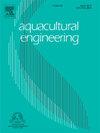Towards understanding the dynamic behaviour of bioflocs in a fish tank culture: Integration of fish growth and activated sludge modelling
IF 4.3
2区 农林科学
Q2 AGRICULTURAL ENGINEERING
引用次数: 0
Abstract
Biofloc can improve the nutrient use efficiency of an aquaculture system. However, knowledge of the dynamic behaviour of biofloc related to the nutrient concentration in the water is limited. This study combined the fish growth model with the activated sludge model (ASM), later called fish-ASM, to understand the dynamic behaviour of biofloc in Nile tilapia culture. Fish were fed two types of diets that differ in fiber content. One of the diet contains three times higher fiber, which was formulated by incorporating more non-starch-polysaccharides (NSP). NSP is expected to increase carbon content in the water and promote more biofloc growth. Initial model parameter values were gained from experiments and ASM number 1. In fish-ASM, waste comes from uneaten feed, fish faeces, decay of heterotrophic and autotrophic biomass, and fish gill excretion (ammonia). Heterotrophic and autotrophic biomass then utilize the waste as substrates for their growth and part of the biomass is consumed by fish as natural food. The main model outputs in this study are hourly dynamics of fish, biofloc, and nitrogen in water. After trial and error calibration process, the model was fit to the fish, biofloc, and nitrogen dynamics of the lower fiber diet datasets with relative mean square error of 3 %-34 % to the corresponding average observations. However, future improvement was needed in the higher fiber diet simulation, especially related to biofloc and ammonia dynamics. The study shows that the development of biofloc was strongly influenced by organic matter availability.
迈向了解鱼缸养殖中生物絮团的动态行为:鱼类生长和活性污泥模型的整合
生物絮团可以提高养殖系统的养分利用效率。然而,对水体中营养物浓度对生物絮团动态行为的影响认识有限。本研究将鱼类生长模型与活性污泥模型(ASM)(后来被称为fish-ASM)相结合,以了解尼罗罗非鱼养殖中生物絮团的动态行为。鱼被喂食两种纤维含量不同的食物。其中一种日粮的纤维含量是原来的3倍,其配方中加入了更多的非淀粉多糖。NSP有望增加水中的碳含量,促进更多的生物絮团生长。模型初始参数值由实验和ASM 1得到。在鱼类asm中,废物来自未食用的饲料、鱼类粪便、异养和自养生物量的腐烂以及鱼鳃排泄物(氨)。异养和自养生物量然后利用废物作为其生长的基质,部分生物量被鱼类作为天然食物消耗。本研究的主要模型输出是鱼类、生物群落和水中氮的小时动态。经过试错校准过程,该模型与低纤维饲料数据集的鱼类、生物群落和氮动力学拟合,相对均方误差为3 %-34 %。然而,在高纤维日粮模拟中,特别是在生物絮团和氨动力学方面,还需要进一步的改进。研究表明,生物絮团的发育受有机质有效性的强烈影响。
本文章由计算机程序翻译,如有差异,请以英文原文为准。
求助全文
约1分钟内获得全文
求助全文
来源期刊

Aquacultural Engineering
农林科学-农业工程
CiteScore
8.60
自引率
10.00%
发文量
63
审稿时长
>24 weeks
期刊介绍:
Aquacultural Engineering is concerned with the design and development of effective aquacultural systems for marine and freshwater facilities. The journal aims to apply the knowledge gained from basic research which potentially can be translated into commercial operations.
Problems of scale-up and application of research data involve many parameters, both physical and biological, making it difficult to anticipate the interaction between the unit processes and the cultured animals. Aquacultural Engineering aims to develop this bioengineering interface for aquaculture and welcomes contributions in the following areas:
– Engineering and design of aquaculture facilities
– Engineering-based research studies
– Construction experience and techniques
– In-service experience, commissioning, operation
– Materials selection and their uses
– Quantification of biological data and constraints
 求助内容:
求助内容: 应助结果提醒方式:
应助结果提醒方式:


